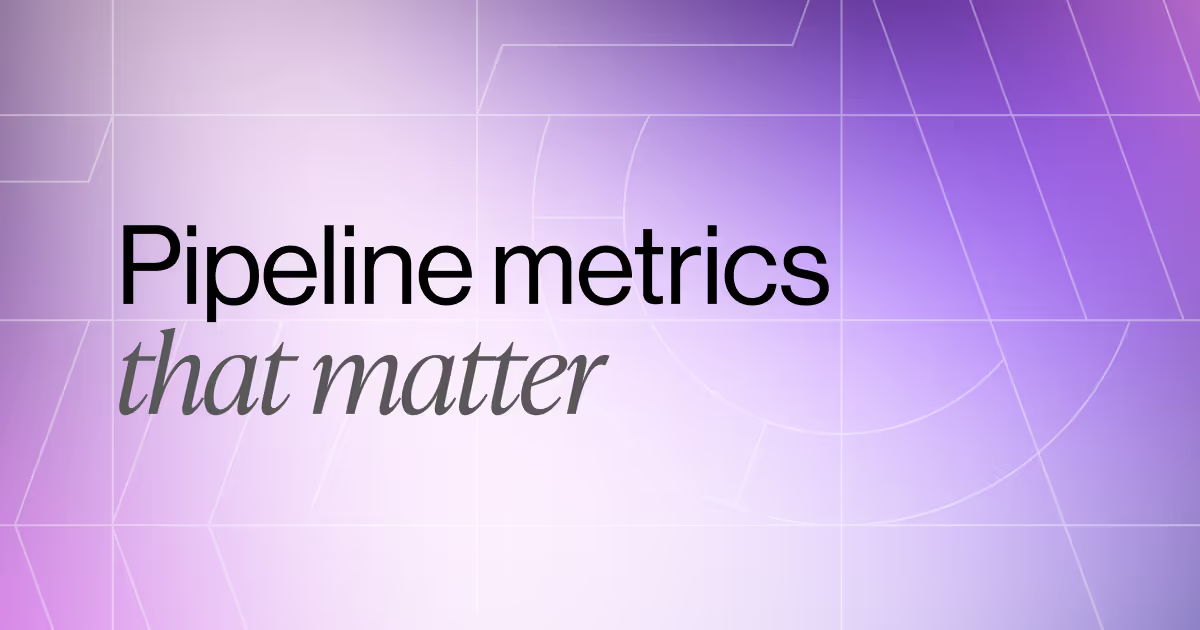Sales Pipeline Analysis: Complete Guide to Pipeline Health & Optimization
It's almost the end of the quarter, and you're on track to hit your revenue goals. But, at quarter's end, your sales team fails to close a number of deals, leaving you with a much lower conversion rate. The problem starts with how you calculate your sales forecast. You relied on total deal value in your CRM, not considering where deals were in your pipeline.
This is why conducting a sales pipeline analysis is important. It’s the practice of analyzing your sales process to understand how fast it’s moving and how likely you are to close deals. It helps you spot blockages in your sales funnel and predict revenue more accurately. This information helps your team focus their efforts on areas where they’ll make the biggest impact, such as advancing stalled high-value deals or re-engaging qualified leads.
In this guide, we’ll examine sales pipeline analysis, key metrics to track, and frameworks for assessing pipeline health. We’ll also share some advanced techniques to optimize your pipeline.
What Is Sales Pipeline Analysis?
Sales pipeline analysis looks at every stage of your sales process to understand how deals move through it so you can identify patterns, bottlenecks, or risks.
Through this process, you’ll gain the information you need to make informed decisions that will improve every stage of the pipeline and boost sales performance.
Sales pipeline analysis:
- Helps you carry out sales forecasting and revenue forecasting so you can allocate resources effectively, set realistic sales targets, and address potential gaps before they impact your targets.
- Keeps sales leaders, reps, and revenue operations aligned by giving everyone the same up-to-date view of deals and progress. It ensures all teams work toward the same revenue goals.
For example, your pipeline analysis shows that most deals move quickly through discovery and demos but consistently stall at the proposal stage. This pattern tells you there’s likely a problem with follow-ups or proposal quality. Once you identify this bottleneck, you can provide additional training, refine your proposal process, or adjust timelines to get deals moving again and improve conversion rates.
Essential Pipeline Metrics to Track
To carry out your pipeline analysis, you’ll need to track sales pipeline metrics and key performance indicators (KPIs). The right metrics will help you understand how leads move through the different stages of the sales process, from initial contact to a closed deal.
The following are some essential sales pipeline metrics that will help you spot inefficiencies and optimize your sales process.
Pipeline Velocity
Pipeline velocity (or sales velocity) tells you how quickly and effectively deals are moving through your sales pipeline. Calculating pipeline velocity reveals both how fast revenue flows through your pipeline and where inefficiencies are slowing deals down.
To calculate it, you’ll need:
- Number of opportunities – How many qualified leads are currently in the pipeline
- Average deal size – The typical value of those opportunities
- Win rate – The percentage of opportunities that become closed-won deals
- Sales cycle length – The average time it takes to close a deal
You then use those metrics in the following equation:
(number of opportunities x average deal size x win rate) ÷ sales cycle length
This equation will help you understand the relationship between all of these metrics. The typical B2B sales cycle lasts a little over two months — if yours is significantly longer, it could signal bottlenecks or inefficiencies to address.
Conversion Rate
Conversion rate analysis looks at the percentage of opportunities that move through your sales pipeline stages. This could be how many qualified leads become qualified opportunities, or how many deals advance from demo to proposal. Tracking conversion rates gives you a clear picture of the customer experience. You know at which sales stages prospects drop off and where your sales process is strong.
To calculate stage-by-stage conversion rates, use the following equation:
(number of opportunities that advance to the next stage ÷ total opportunities that entered the current stage) × 100
Measuring stage-by-stage conversion rate is another great way to eliminate bottlenecks and create opportunities for improvement in your sales efforts. For example, if many qualified leads fail to move past the demo stage, you might need to adjust your demo strategy, train reps on objection handling, or refine lead qualification criteria.
Pipeline Coverage and Quality
Pipeline coverage measures how much potential revenue is sitting in your sales pipeline compared to your revenue targets. A common benchmark is maintaining anywhere from three to six times your quota in pipeline value to comfortably hit your sales goals.
But coverage alone doesn’t guarantee success. You’ll also want to check your pipeline quality. Look at whether the opportunities sitting in your pipeline are truly qualified or quality leads that are likely to close. A pipeline stuffed with unqualified deals gives a false sense of security and can wreck your forecasts.
To analyze coverage and quality:
- Determine pipeline coverage: Calculate total pipeline value ÷ revenue target.
- Assess deal quality: Review lead qualification, stage fit, and historical win rates.
- Spot red flags: Look for low-quality opportunities, outdated stages, or overreliance on a few high-value deals.
Stage Duration and Bottlenecks
Stage duration is the average amount of time a deal spends in each stage of your sales pipeline. Bottlenecks are the points where deals stall or slow down, creating friction that delays revenue and reduces conversion rates. Tracking stage duration helps you spot these bottlenecks that could be costing you valuable sales opportunities.
Use your CRM dashboards or pipeline reports to monitor:
- The average time deals spend in each stage (e.g., demo, proposal, negotiation)
- Where deals most often get stuck or drop off
- Trends over time that show whether stage durations are improving or worsening
When looking for bottlenecks, you might notice that some proposals sit unanswered for weeks or that contracts often stall in legal review. In response, automate follow-up reminders for reps, introduce proposal-review deadlines, or involve legal earlier in the sales process. These targeted improvements to your workflows can keep deals moving and prevent delays.
Win Rate
Win rate is the percentage of opportunities that ultimately become closed-won deals. It’s one of the most direct indicators of pipeline health and sales team effectiveness. If your win rate starts to dip (a good win rate is anywhere above 50%), this could signal issues such as poor lead qualification, issues with your pricing, or competitive pressure.
To calculate win rate:
win rate (%) = (number of closed-won deals ÷ number of qualified opportunities) × 100
Study win rates for different products, territories, or sales reps to spot trends. You might notice that certain regions consistently outperform others, or one product line lags behind the rest. Monitoring win rate over time helps you identify weaknesses in your sales process and make data-driven decisions about training, strategy adjustments, or resource allocation.
Pipeline Analysis Framework
A structured framework creates an effective sales pipeline analysis process, ensuring you’re looking at the right data, spotting issues early, and translating insights into action. Here are the steps to take to standardize your pipeline analysis approach and consistently improve your pipeline health and forecast accuracy.
1. Data Collection and Standardization
Start by gathering all relevant sales data from your CRM and any connected tools. You’ll want to collect current and historical data like deal values, number of deals, close dates, stage progression, and activity logs. But the real work starts before you pull the reports. First, make sure sales reps log information consistently so the data you collect is usable. If you notice gaps or mismatched terms (e.g., missing fields, different labels for the same activity), create clear data-entry standards, add required fields in your CRM, and run periodic audits to catch inconsistencies early.
For example, imagine two sales reps use different terms for the same type of information. One logs a product demo as “demo,” the other calls it “presentation.” This inconsistent logging of CRM data leads to messy and misleading information, making it harder to spot issues or forecast revenue growth accurately.
Standardize fields and definitions to prevent gaps or duplicates that can skew your results. Clearly define each stage of your sales process (e.g., what qualifies as a “demo” or a “proposal”), lock key fields as required in your CRM, and use picklists or dropdowns instead of free-text wherever possible. Clean, uniform data gives you a trustworthy foundation for identifying trends, diagnosing bottlenecks, and making informed decisions about your sales strategy.
2. Pipeline Health Assessment
Assessing pipeline health means checking whether your sales pipeline is balanced, moving smoothly, and capable of meeting your revenue targets.
Start by comparing your total pipeline value to your revenue goals. If the total value of deals in your pipeline isn’t three to four times your revenue goal, you may not have enough opportunities in play. Look at how deals are distributed across stages. A pileup in one stage or too many late-stage deals slipping backward can signal issues such as stalled negotiations, unclear next steps, or reps needing additional support or resources.
Use your CRM dashboards or pipeline reports to visualize these trends over time. Spotting irregularities early allows you to reallocate resources, adjust outreach strategies, or refine lead qualification before revenue takes a hit.
3. Bottleneck Identification
After you’ve assessed overall pipeline health, pinpoint the bottlenecks causing your deals to consistently slow down or fall out.
To find them, compare stage duration data across your pipeline to spot stages where deals linger far longer than average. Then, look for patterns, such as frequent stalls after pricing discussions or demos. Also watch for long gaps in follow-ups, deals that repeatedly bounce between stages, or prospects going silent after proposals.
Finally, review rep feedback and CRM notes to understand what’s causing delays, such as unclear follow-ups or inadequate enablement materials. Once you’ve identified a bottleneck, dig into the cause and develop a targeted fix. For example, if deals frequently stall after pricing conversations, you might refine your pricing strategy, offer clearer discount guidelines, or create battle cards to help reps handle cost objections confidently.
4. Conversion Rate Insights
Take the conversion rate analysis you did earlier and go deeper by comparing rates across different teams, stages, or segments. For example, if one territory converts 15% lower than the rest, dig into the data behind those deals. Check call notes or CRM activity logs to see if reps are following up as often, review pricing feedback from prospects, and compare lead qualification criteria to ensure the same standards are being applied.
This exercise is all about looking for patterns. Do certain sales reps close deals faster after demos, or do specific products stall at negotiation? These insights help you focus coaching, adjust your sales strategy, or refine lead qualification criteria so more opportunities progress smoothly through your pipeline.
5. Forecasting Accuracy Review
How accurate were your past sales forecasts? Did they match actual closed revenue? Compare projected deal values and close dates in your CRM with what really closed and when.
If there are gaps, identify where they came from. Were deals slipping between stages without follow-ups, were win rates overestimated, or was the sales cycle length misunderstood? These gaps show where your forecasting assumptions break down and will help you refine your sales forecasting methods. Armed with this information, you can set realistic revenue targets and make data-driven decisions about resources and sales strategy.
6. Action Plan Development
Now, it’s time to take all of the insights you’ve gathered and put them to work. Everything you learned from your pipeline analysis, bottlenecks, conversion rates, and forecasts needs to be translated into an improvement plan.
Prioritize fixing the issues with the biggest revenue impact by refining lead qualification, shortening stage duration with better follow-ups, or giving targeted coaching to reps struggling at specific stages. Assign clear owners, set measurable goals (e.g., raise win rate by 5% or cut average sales cycle length by 10 days), and add deadlines. Finally, revisit these actions regularly (monthly or once per quarter) to track progress and adjust so your pipeline stays healthy and your revenue goals remain achievable.
Common Pipeline Problems (& How to Solve Them)
Managing a sales pipeline often means dealing with unexpected problems — but the good news is that most sales activity issues are predictable and fixable once you know what to look for.
Below are four of the most common pipeline problems and practical ways to solve them.
Stalled Deals and Long Cycles
Few things frustrate a sales team more than deals that seem promising initially but stall out or drag on for months. Maybe the potential customer’s budget shifted or a key decision-maker left. Whatever the reason, those stuck deals clog up your pipeline, tie up rep time, and can skew your sales forecasts because stalled deals still show up as active opportunities even though they’re unlikely to close.
To address stalled deals and quicken your sales cycle, analyze stage duration for where opportunities consistently stall. Once you identify the sticking points, you can act. Provide reps with better sales enablement materials, streamline approval workflows, or introduce clear next steps after every customer touchpoint.
Low Conversion Rates
Low conversion rates are a sign that too many opportunities are dropping out as they move through your sales pipeline. Sometimes prospects aren’t the right fit to begin with, or deals drag on so long that interest fades. In other cases, misaligned pricing or confusing handoffs between marketing and sales cause leads to fall through the cracks.
To improve conversion rates, focus on quality over quantity. Make sure your marketing and sales teams agree on what defines a qualified lead, and provide reps with clear playbooks for discovery, demos, and follow-ups. Review win–loss data to help you understand why deals are lost, so you can refine messaging, improve training, or adjust pricing strategies.
Inaccurate Forecasting
If your forecasts are off, it’s usually because the data feeding them isn’t reliable. If sales reps update your CRM inconsistently, or if stalled deals are left sitting in late stages, your pipeline looks healthier than it really is. Forecasting also becomes inaccurate when you rely on old assumptions, like expecting the same win rates or deal timelines, even though market conditions have changed.
To fix this, make sure CRM data is cleaned and updated regularly. Review pipeline metrics against historical data and validate assumptions at least quarterly. It’s only when your forecasting is truly accurate that you can set realistic revenue goals and prevent surprise shortfalls at the end of the quarter.
Insufficient Pipeline Coverage
Hitting your revenue targets becomes a matter of luck rather than strategy if your pipeline doesn’t have enough opportunities. A common SaaS benchmark is to maintain three to six times your quota in pipeline value to comfortably hit your sales goals. The right multiple depends on factors like your sales cycle length, average deal size, and win rate.
When coverage is too thin, your reps may waste time chasing every lead instead of focusing on quality opportunities. Instead, double down on lead generation, improve lead qualification, and make sure marketing and sales are aligned on the definition of a quality lead. With stronger coverage, your sales team has the breathing room to lose some deals without worrying about not hitting their revenue goals.
Advanced Pipeline Analysis Techniques
To take your sales pipeline analysis to the next level, try these advanced techniques for deeper insights into what drives performance, to uncover hidden patterns in your sales data, and to help you make data-driven decisions that optimize your sales process over time.
Cohort Analysis for Pipeline Performance
Split your sales activity into different cohorts so your sales pipeline isn’t just one big pool of potential deals. You can group them by the month they entered the pipeline, the region they’re from, or the product line they’re tied to. Then, compare how these different cohorts perform over time.
For example, you might see that deals created in Q1 close faster than those created in Q2, or that customers in one region have a higher average deal size than those in another.
This type of analysis helps you uncover patterns that explain why some deals move smoothly through the sales cycle while others stall. From there, you can apply the lessons learned from high-performing cohorts to the rest of your pipeline.
Predictive Analytics for Deal Outcomes
Predictive analytics uses historical sales data and machine-learning models to forecast how likely a deal is to close. Instead of relying on gut feel or rep intuition, predictive analytics uses data points like deal size, pipeline stage, activity history, and response times to calculate close probabilities.
For example, the data might show that deals with more than three levels of decision-making have a much lower chance of closing, or that opportunities with fast response times in the early stages tend to move through the sales cycle more successfully.
Predictive analysis helps you prioritize your team’s efforts. Reps can focus on high-likelihood opportunities while managers get early warnings about at-risk deals, improving both pipeline health and forecast accuracy.
Territory and Rep Performance Analysis
Territory and rep performance analysis looks at how individual sales reps and territories contribute to pipeline health. This will allow you to see where opportunities are strong and where they’re lagging.
For example, one territory might have plenty of qualified leads but a consistently low win rate, which suggests the market is saturated or pricing is off. At the rep level, you might see that one salesperson is closing deals quickly while another takes much longer to move opportunities through the same stages.
Track these differences to spot coaching opportunities, balance workloads across your sales team, and allocate resources where they’ll have the biggest impact on revenue growth.
Product Mix and Pipeline Health Analysis
Your sales pipeline isn’t only shaped by who you’re selling to but also by what you’re selling. Product mix analysis looks at how different offerings perform in the pipeline and how they influence overall revenue health.
High-value enterprise products may have a longer sales cycle but a bigger payoff, while add-on products or upsells might close faster and keep your win rate steady. If too much of your pipeline is concentrated in one product line, you risk missing revenue targets when those deals stall.
Balance your product mix with a healthy spread of high-value and fast-moving deals that give you more reliable forecasts and steadier revenue growth. Aim for a mix where a meaningful portion of your pipeline (often 30–50%) comes from smaller, faster-closing deals that can offset slower enterprise opportunities.
Connect Pipeline Insights to Compensation and Performance With CaptivateIQ
The right tools can simplify and enhance sales pipeline analysis. CaptivateIQ helps you go beyond visualizing your sales pipeline and connects that insight directly to quotas, compensation, and performance.
Real-time dashboards give you a visual representation of your pipeline health and revenue forecasts so you can make informed decisions instead of chasing outdated spreadsheets. CaptivateIQ Planning lets you align quotas and resources with pipeline trends and ensures your revenue operations stay on track.
CaptivateIQ’s incentive management tools tie compensation directly to the sales activities that matter most, such as advancing qualified leads through the pipeline, closing high-value deals, or securing renewals and upsells.
Bring your sales, RevOps, and finance teams together on one platform to streamline workflows and help you hit your revenue goals with confidence.
Ready to see how CaptivateIQ can optimize your pipeline and compensation strategy? Book a demo today.
Sales Pipeline Analysis FAQs
What are the most important pipeline metrics?
Key sales pipeline metrics include pipeline velocity (how quickly deals move), conversion rates at each stage, pipeline coverage (value of opportunities compared to quota), win rates, and stage duration. Tracking these metrics gives you a clear view of pipeline health and helps you spot bottlenecks before they slow down revenue.
How often should pipeline analysis be conducted?
Most sales teams review their pipeline weekly to keep forecasts accurate and catch issues early. A deeper analysis should be done monthly or quarterly to guide strategy and resource allocation. Here, you’d look at patterns in conversion rates, deal value, and rep performance.
How do you improve pipeline conversion rates?
To improve conversion rates, focus on lead qualification, tighten up follow-ups, and make sure reps are trained to handle objections at each stage of the sales cycle. Use pipeline analysis to see where deals are stalling, then address root causes — whether that’s better training, clearer messaging, or stronger sales enablement content.
What causes pipeline stagnation?
Stagnation happens when deals stall in one stage for too long. Common causes include poor lead qualification, lack of decision-maker involvement, pricing concerns, or inconsistent follow-up. Pipeline analysis helps you identify these issues early to re-engage prospects, adjust strategy, or remove dead deals to keep the pipeline healthy.
.svg)


.png)





